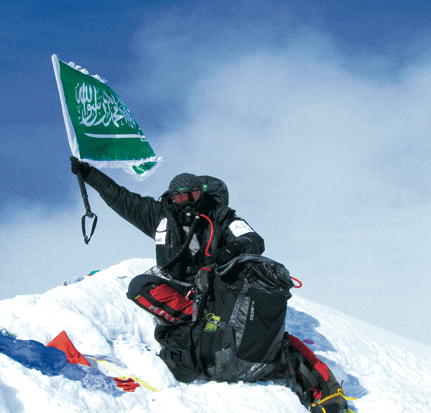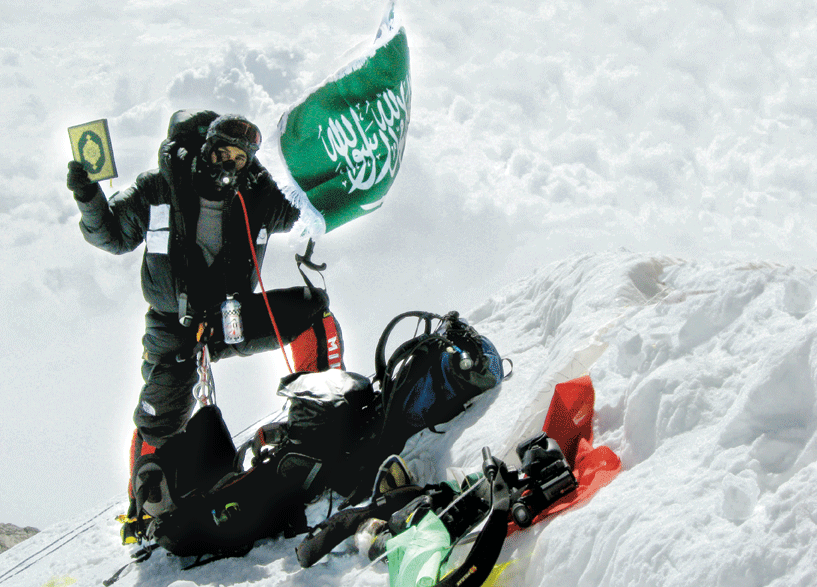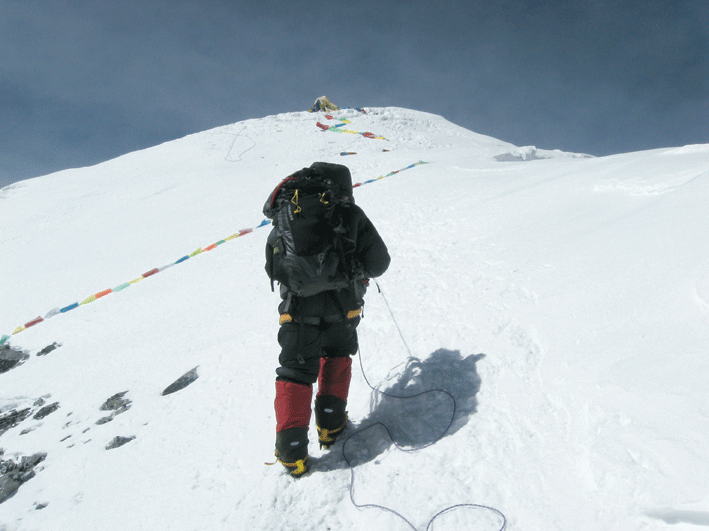
Adventure
Farouk Al-Zuman The First Saudi on the Ceiling of the World
In an interview with Arab News in Katmandu, Al-Zuman recounted his personal experiences during the expedition.

By: Ghazanfar Ali Khan *
KATMANDU - His was a climb for peace. Farouk Saad Hamad Al-Zuman made a call for prayer from the summit of Mount Everest, a first to be recorded in the Islamic history of exploration and adventure. Not only this, he was the first to perform prayer after unfurling the Saudi flag on the top of the 29,035-foot peak.
In an interview with Arab News in Katmandu, Al-Zuman recounted his personal experiences during the expedition, which he says were full of horror, tragedy, ecstasy and nostalgia. “I faced life-and-death situations and, at times, it was difficult to hold the body straight because of freezing cold and depleting oxygen as you go up and up,” said the 30-year-old who, on May 21, became the first Saudi to ascend to the peak of the world’s highest mountain.
“I did not feel any problem at the Everest Base Camp, which is set up at 17,000 feet,” he said. “But I really felt a bit uncomfortable at Advance Base Camp and at the final hurdles crossing the two other camps before the final push to the top.”
He spoke highly about the Nepalese Sherpas of the Himalayas, who know the mountains well and serve as guides, and thanked Willie Benegas, a mountain guide from Argentina, who helped him a lot while his movement was hampered from Camp 4 to Camp 2 because of snow blindness.
Al-Zuman received a medal from Nepalese government for his feat. He regularly visited Norvic International Hospital where one of his teammates, Sultan from Oman, is currently recovering from fatigue and frostbite. Sultan is now doing well.
Referring to the threats to the lives of climbers, he said: “As I ascended above base camp, the sheer physical exertion of the climb and the lack of oxygen started to take their toll on me. The trek became increasingly perilous, particularly after the third camp when I entered the dead zone, where the body begins to shut down and the mind loses focus.”
“I Was Just in Awe”
Asked how he felt on reaching the summit, he said: “I was just in awe. I couldn’t believe I was there, I just couldn’t believe it. It’s the most glorious and magnificent place on earth. It’s quite a privilege to look at it. When I got to the top the sun was there with its sunshine at 3 p.m. Nepali time. There were some clouds also hovering over other parts of the mountain and its peaks and the mighty mountain tops underneath us which was just amazing.”
Prince Sultan bin Salman, secretary-general of the General Commission for Tourism and Antiquities, was the first to congratulate Al-Zuman early this week after his satellite phone began working at the camp.
A few high-profile felicitations were also organized for Al-Zuman in Katmandu this week. These recognitions on the part of the Nepalese government are also important because Katmandu announced last week that May 29 -the date Sir Edmund Hillary and his Nepalese Sherpa Tenzing Norgay conquered the world’s highest peak in 1953 -will be marked as International Mount Everest Day.
Asked about the natural hazards like blizzards, snowing and dangerous animals, Al-Zuman said: “Mount Everest can be called both the highest mountain and the highest graveyard in the world. As of 2002, 175 climbers have died on the mountain -more have died since -and the vast majority of these bodies were left behind.
“At least 41 bodies on the north side of Everest are still there. I myself saw several bodies, while trekking. Some people simply run out of gas on the trail and freeze to death.”
Avalanches consume other climbers, and removing bodies from this elevation is an enormous task. Some bodies are never found, or are found and left in state due to the difficulties involved with bringing them back down.
“The high altitude, low oxygen, fierce winds, and intense cold make the trip extremely challenging even for an unencumbered person, so few climbers attempt to take the bodies of the deceased back with them,” he said. “I myself touched the face of a climber in the mistaken notion that he is alive,” said Al-Zuman. “After I patted on the face of the man, my Sherpa said that the climber has been dead for months or years.” Al-Zuman said that the bodies are well preserved due to the freezing climate.
Expensive Feat
Climbing Everest is not only an extreme physical challenge, but also a rare and expensive feat. Since Hillary and Tenzing reached the roof of the world 55 years ago, about 3,800 climbers have attempted the climb; about 1,600 have succeeded. Some adventure tourists pay up to $40,000 for the honor -or at least the attempt at the honor.
“This adventure needs sacrifice and a zeal to face challenges,” said Al-Zuman. “I think the toughest bit was being away from family and friends for two months and living in tents.”
“At certain moments we are still weary, and the first thing we did was take off our stinking clothes,” said Al-Zuman. “I don’t know whether to burn or wash our clothes.”
Climbing Everest is a major feat, but Al-Zuman said that the return trip -when climbers are exhausted -is much more difficult. “Getting up Everest is the easiest part of the climb. Dealing with the impact of altitude, physical exhaustion and sleep depravation on the way down is the most dangerous part of a summit attempt.”
Addressing a press conference organized by the Media Group of Nepal at Katmandu Reporters Club, Al-Zuman also expressed his appreciation for the Nepalese government. He said that Saudi Arabia and Nepal could cooperate in the tourism and mountaineering sectors besides business and cultural spheres.
* Ghazanfar Ali Khan is a journalist of Arab News